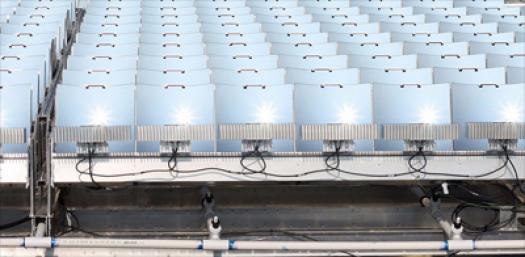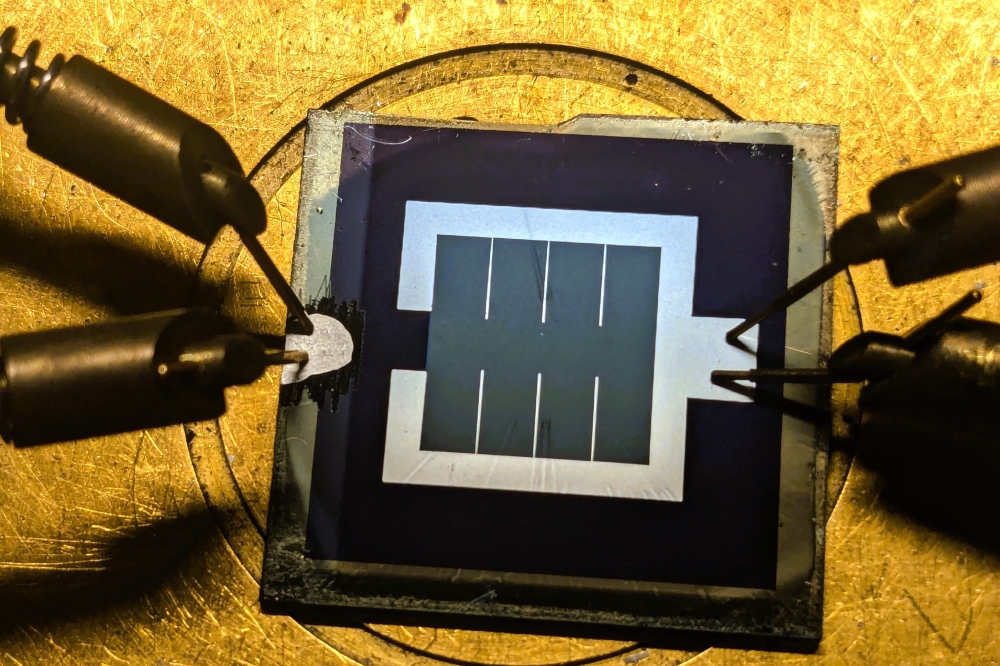Tracking CPV

Q: Twenty years ago, when the first issue of Compound Semiconductor went to press, there wasn't a CPV industry based on multi-junction cells. But research into CPV systems was under way. Who were the pioneers, what were their accomplishments, and what was the state-of-the-art at that time?
A: Twenty years ago it was all silicon based. We had companies like ENTECH, which was one of the leaders for a low-X silicon concentrator. And Amonix was a leader for a high-concentration silicon concentrator.
Q: What were the types of cells and the concentrations being used in those prototype systems?
A: ENTECH was doing something on the order of 20X. There was another company called PV International that tried to launch something that was more like 7X, but that never got to the point of hundreds of kilowatts. Amonix then was using more like 200X, and they did get that deployed to a total of approaching 10 MW "“ it may have been 7 MW or 8 MW; I'm not sure what the final count was.
Q: What were the key breakthroughs made by researchers in the late 1990s and early 2000s to enable CPV to be considered as a possible commercial solar technology?
A: I think that the excitement that came with CPV was when the multi-junction cell passed 25 percent [efficiency], and then in the early 2000s as those crept up passed 40 percent. That inspired a whole different approach and attitude. If the cell efficiencies are comparable, then the advantage is only in terms of being able to use less semiconductor material. This is still a very valid approach, but this doesn't have quite the same level of excitement as when you are looking at module efficiencies that will eventually be 40 percent, and are now about 35 percent.
Q: Which companies played a leading role in moving CPV from the demonstration of a technology to fledgling industry?
A: Amonix was the first company to demonstrate multi-megawatts with silicon. They were also the first company to demonstrate [large-scale systems with multi-junction cells], they put in a 30 MW plant in Alamosa, [Colorado]. So I would say that they were a real leader. Soitec is then following after Amonix, and has surpassed its early lead. At this point in time Soitec would be considered the leader.
Q: Towards the end of the last decade, the CPV industry suffered from a double whammy of plummeting prices for silicon PV and the global financial crash. Had neither of these occurred, do you think there would be a substantial CPV industry by now?
A: If a CPV company had been ready to launch at the time when there was the silicon shortage "“ what you saw was that First Solar grew into that void "“ I'm fully convinced that they would have grown just as First Solar grew.
Q: What lessons have been learnt from the failure of many players in CPV?
A: I think the challenge of the scale-up being quite formidable is a lesson that is learned. [Another is] the need for a large investment in order to get over that hurdle "“ I'm not sure that it brings that hurdle down, but to understand that hurdle is high may help some companies plan.
Q: How do you feel about the tough times that the CPV industry has faced?
A: It is so sad to lose all the different companies, and the different approaches, when we haven't really figured out which approach works best.
Q: In terms of cell architecture, what do you consider to be the big breakthroughs of the last 20 years?
A: Solar Junction making dilute nitrides with antimony has laid out a path to high-efficiency multi-junction cells, but the metamorphic multi-junction structure is also laying out a path to be able to reach very high efficiencies. Soitec just announced another record efficiency, but whether the bonded approaches will yet take off is not yet clear. So those are three different approaches to the high efficiency, and they all are very promising, and which of them will turn out to be a winner in the long run is not clear to me.
Q: Has the design of modules and tracker systems improved significantly during the last two decades?
A: Certainly. Some of the biggest increases in efficiency in modules have come from improvements in optical design. There were a few years in particular where all the improvements were coming from that. The tracker systems: It's such a straightforward technology in that it's not rocket science, but it definitely needs optimisation. In my observation, they are making progress.
Q: Both lenses and mirrors have been used to date to focus the sunlight in CPV systems. Is one form of optics going to dominate in the years ahead?
A: Whether lenses or mirrors will dominate is definitely still a fascinating topic. What I have observed was that in the US, back in the 1980s, they came to the conclusion that mirrors could not be used. So all of the investment for a number of years in the US was focused on lenses, whereas in other countries much of the work was focused on mirrors. So it is fascinating to me that the decision that was made, based on the work that was done under the Department of Energy funding in the US, really split the directions of the community. There are advantages to both the lenses and to the mirrors, and in my mind it is not clear yet what direction it will go.
Q: What are your thoughts on the suppliers of multi-junction cells today? Are there enough chipmakers that produce devices of sufficient quality to support a ramp in shipments of CPV systems?
A: People have been worried about this for the last decade or so. I have told them that we have far too many cell suppliers. It is very difficult to believe that we could end up with a shortage of cell suppliers "“ there are so many different companies that would be capable of doing that, and would be able to ramp up. It is so easy for them to ramp up. The technology is now so well developed, and has so many different options.
The problem right now is that we don't have the business for them, so they are not going to invest. If we are trying to split a market that is not big enough for one company, and we're trying to split it between multiple companies, none of them will have a sustainable business model.
Q: Since the birth of the CPV industry, is it now harder than ever to raise cash?
A: Yes, by far. It is partly because there have been so many PV, thin-film companies and some CPV companies, and so many of them have been unsuccessful. The profit margins are now so small.
In the silicon space, silicon has moved so far down its learning curve that it is very difficult to compete with it. So the amount of funding that you need to get the scale up that is needed to get the price down to compete with silicon is very big. The biggest hope that the CPV industry has at this point in time is if we could develop another shortage of silicon, as happened once before. Then CPV could grow into that, and in that case they would be able to grow easily. But without that, it would take a company with very deep pockets to be able to get this over the hurdle.
Back in early 2009, the global financial crisis made it very tough for many of the fledgling CPV companies seeking to raise further investment. This included GreenVolts, which at that time was building a 2 MW CPV plant in Tracy, California. Fast-forward three years to 2012 and the company was laying off most of its staff and looking for a buyer of its assets or technology.
The question is: Will one of today's companies demonstrate the technology, and the confidence in that, that a company with deep pockets would be willing to put money in and scale it up? Or will somebody come up with an approach that allows you to find an entry market, that allows it to be sold at a higher price as you make that transition?
The C7, [a system by SunPowerthat has been reported to have a 3 GW pipeline], is in my mind potentially one of the biggest developments that has happened in the last five years. It's almost like a big secret. I'm not sure how far along, or whether it could run into snags, but certainly the plans Sunpower has for the C7 are pretty spectacular.
Q: A substantial proportion of CPV technology has been developed in Europe and the US. However, in recent times Chinese companies have acquired Emcore's CPV division in Albuquerque, the CPV part of Soitec, and the assets on Concentrix. So is the future of CPV now in Chinese hands?
A: I think the future of CPV is in the hands of a company with deep pockets who is willing to make the investment. It is not clear to me that the Chinese companies have both the financial and technical capabilities to pass over that hurdle.
It's very clear to me that the CPV industry has the potential to be a major player within the industry, but the investment that will be needed to be taken to get from here to there will be substantial. It's not going to be done by a small company. It may start as a small company, but eventually it's going to have to have a very large company behind it to be able to be successful. Whether that is a Chinese company or a US company or a European company I don't know. All I know is that they'll have to have deep pockets.
Q: Where could CPV be in 20 years' time?
A: If there is a shortage that develops that allows an opening for CPV to grow into, I think it could be a substantial player in the locations that are hot with clear skies. A second scenario is that the C7-type approach may turn out to be a very important technology, and a third possibility is that it will lose all of its current people, and the multi-junction technology will be mostly used in space, including CPV in space.
In the 1990s, efficiencies at high concentrations for multi-junction cells surpassed those for silicon, igniting greater interest in this form of solar technology. Since then, cell efficiencies have continued to climb, with the current record standing at 46 percent for a four-junction cell made by Soitec.


































